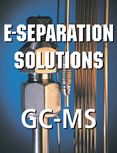Techniques for Reducing Purge-and-Trap Cycle Times in VOC Analysis
The purge-and-trap (P&T) technique for analysis of volatile organic compounds (VOCs) was pioneered in the 1970s at the United States Environmental Protection Agency (USEPA) research laboratory in Cincinnati. Many of the operational parameters developed during this time period are still included in USEPA methods. While these parameters still produce good analytical results, they do not take advantage of advances in instrumentation that enable analysis of emerging contaminants such as fuel oxygenates, and increased sample throughput.

This information is supplementary to the article “Accelerating Monoclonal Antibody Quality Control: The Role of LC–MS in Upstream Bioprocessing”, which was published in the May 2025 issue of Current Trends in Mass Spectrometry.
Investigating the Protective Effects of Frankincense Oil on Wound Healing with GC–MS
April 2nd 2025Frankincense essential oil is known for its anti-inflammatory, antioxidant, and therapeutic properties. A recent study investigated the protective effects of the oil in an excision wound model in rats, focusing on oxidative stress reduction, inflammatory cytokine modulation, and caspase-3 regulation; chemical composition of the oil was analyzed using gas chromatography–mass spectrometry (GC–MS).






